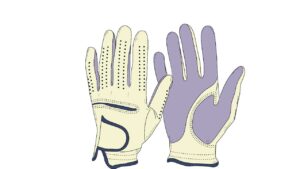Golf, a sport of precision and finesse, requires players to be in complete control of their movements, including the grip on their clubs. A crucial accessory aiding in this control is the golf glove. But how long does this essential piece of gear last before it needs replacement? Let’s delve into the factors influencing the lifespan of a golf glove and strategies to maximize its longevity.
Factors affecting the lifespan of a golf glove
Several factors contribute to determining how long a golf glove will remain functional. These include the quality of materials used, the frequency of use, and the care and maintenance practices adopted.
Material quality
One of the primary determinants of a golf glove’s longevity is the quality of materials used in its construction. Golf gloves are commonly made from either leather or synthetic materials, each with its own set of advantages and disadvantages.
Leather gloves are renowned for their durability and superior grip, making them a popular choice among serious golfers. However, they require proper care to maintain their quality and can be more susceptible to wear and tear over time.
On the other hand, synthetic gloves are often more affordable and resistant to moisture, making them suitable for wet conditions. While they may not offer the same level of durability as leather gloves, advancements in synthetic materials have narrowed the gap significantly.
Frequency of use
Another critical factor influencing the lifespan of a golf glove is how frequently it is used. Professional golfers who spend hours on the course each day are likely to wear out their gloves much quicker than occasional players who only golf on weekends.
Additionally, the intensity of practice sessions can also impact glove longevity. Golfers who frequently hit balls at the driving range or participate in rigorous training drills may find their gloves wearing out faster than those who engage in more casual play.
Signs of wear and tear
Despite the best care practices, golf gloves will eventually show signs of wear and tear. Visual inspection is the most straightforward method for determining when a glove needs replacement. Look for any tears, holes, or areas of excessive wear on the palm and fingers.
Loss of grip is another common indicator that a glove has reached the end of its lifespan. If you find yourself struggling to maintain a firm grip on the club, it may be time to retire your old glove and invest in a new one.
How long should a golf glove last?

It’s tough to say exactly how long a golf glove will last because it depends on a few factors:
- How often you play: Professional golfers who play every day might replace their gloves after every round! But for casual players, a glove could last anywhere from 10 to 50 rounds, depending on the quality and care.
- Material: Leather gloves tend to last longer than synthetic ones, but they also require more maintenance.
- Care: If you take good care of your glove by letting it dry completely after each use and storing it properly, it will last longer.
Here’s a general guideline:
- Amateur players: 10-15 rounds
- Frequent players: 3-4 months
No matter how often you play, it’s important to replace your glove when it starts to show signs of wear and tear, like rips, stiffness, or loss of grip. A worn-out glove can hurt your game by affecting your grip and feel.
How do you know if you need a new glove?

There are a few telltale signs that it’s time to trade in your old golf glove for a new one:
- Visible Wear and Tear: This is the most obvious sign. Holes, tears, or excessive stitching coming loose all mean your glove’s protective abilities are compromised.
- Loss of Grip: A good glove should provide a secure grip on the club. If you feel like the club is slipping in your hand, or the glove material feels slick, it’s time for a replacement.
- Shrinking or Tightness: Leather gloves can shrink slightly over time, especially if they get wet. If your glove feels too tight and restricts your hand movement, it’s best to get a new one.
- Loss of Shape: If the glove looks baggy or misshapen, it does not provide a snug fit for optimal control.
- Stiffness: Leather gloves can get stiff with age and repeated use. A stiff glove will limit your feel and hinder your swing.
- Exposure to Wet Conditions: Playing in rain or getting your gloves wet can accelerate wear and tear. If your gloves have been through a downpour, they might need replacing sooner than usual.
Even if your glove doesn’t have any glaring issues, consider replacing it every 10-15 rounds (for amateur players) or 3-4 months (for frequent players) to ensure optimal performance.
Read also: Can You Wash Golf Gloves?
Proper care and maintenance
Golf gloves are essential accessories that provide golfers with the grip and control needed to execute precise shots on the course. To ensure that these gloves remain in optimal condition and continue to perform at their best, proper care and maintenance are essential. Here are some tips for effectively caring for and maintaining golf gloves:
1. Cleanliness is Key:
- After each round of golf or practice session, gently clean the glove with a mild soap and water solution. Use a soft cloth or sponge to remove dirt, sweat, and oils from the surface of the glove. Avoid using harsh chemicals or abrasive cleaners, as they can damage the materials.
2. Air Dry Thoroughly:
- After cleaning, allow the glove to air dry thoroughly before storing it. Avoid using heat sources such as hair dryers or direct sunlight, as they can cause the materials to shrink or become brittle. Instead, lay the glove flat on a clean towel and allow it to dry naturally.
3. Avoid Folding or Wrinkling:
- To prevent creases and wrinkles from forming in the glove, avoid folding or crumpling it when not in use. Store the glove flat or gently roll it up to maintain its shape and integrity. Wrinkles in the glove can affect comfort and grip, compromising performance on the course.
4. Use Glove Conditioners:
- Periodically apply a specialized glove conditioner or leather conditioner to maintain the suppleness and flexibility of the materials. These products help prevent the leather from drying out and cracking, prolonging the lifespan of the glove. Follow the manufacturer’s instructions for the best results.
5. Store Properly:
- When not in use, store your golf gloves in a cool, dry place away from direct sunlight and moisture. Avoid leaving them in your golf bag or glove compartment for extended periods, as exposure to heat and humidity can accelerate deterioration. Consider using a glove clip or hanger to keep gloves organized and well-ventilated.
6. Rotate Between Gloves:
- If you frequently play golf or engage in practice sessions, consider rotating between multiple gloves to distribute wear evenly. This allows each glove to dry completely between uses and reduces the frequency of replacements. Rotating between gloves also helps maintain consistent grip and performance on the course.
7. Inspect Regularly:
- Periodically inspect your golf gloves for any signs of wear and tear, such as holes, tears, or loose stitching. Pay attention to areas of high friction, such as the palm and fingers, as these are prone to damage over time. Address any issues promptly to prevent further deterioration.
8. Replace When Necessary:
- Despite proper care and maintenance, golf gloves will eventually wear out and need replacement. Pay attention to the condition of your gloves and replace them as soon as signs of deterioration become evident. Continuing to use worn-out gloves can compromise grip and control, affecting your performance on the course.
Read also: How Much Does a Golf Club Weigh?
Tips for extending the lifespan of a golf glove

Golf gloves are essential accessories that provide golfers with grip, comfort, and control during their swings. To maximize the lifespan of these valuable tools, it’s essential to adopt proper care and maintenance practices. Here are some tips to help extend the lifespan of a golf glove:
1. Rotate Between Multiple Gloves:
Rotating between multiple gloves allows each glove to dry thoroughly between uses, preventing moisture buildup and extending its lifespan. This also helps distribute wear evenly among the gloves, reducing the frequency of replacements.
2. Invest in Quality Gloves:
Investing in high-quality gloves made from durable materials can pay off in the long run. While they may have a higher upfront cost, quality gloves are more resistant to wear and tear, providing better grip and performance over time.
3. Clean and Dry After Each Use:
After each round of golf or practice session, gently clean the glove with mild soap and water to remove dirt, sweat, and oils. Allow the glove to air dry completely before storing it to prevent the growth of bacteria and mold.
4. Use Glove Liners:
Glove liners can help absorb moisture and protect the glove from excessive sweat, prolonging its freshness and lifespan. Additionally, glove liners provide an extra layer of cushioning and comfort for the golfer’s hand.
5. Store Properly When Not in Use:
Store your golf gloves in a cool, dry place away from direct sunlight and heat sources. Avoid leaving them in your golf bag or car for extended periods, as exposure to extreme temperatures can cause the materials to deteriorate prematurely.
6. Avoid Overstretching:
Avoid stretching or pulling on the glove excessively, as this can weaken the materials and lead to premature wear and tear. Choose a glove that fits snugly but comfortably without restricting movement.
7. Replace When Necessary:
Pay attention to signs of wear and tear, such as holes, tears, or loss of grip. Replace your golf glove as soon as these signs become evident to maintain optimal performance on the course.
8. Perform Regular Maintenance:
Periodically inspect your golf gloves for any signs of damage or deterioration. Check the seams, stitching, and palms for any weak spots or areas of concern. Address any issues promptly to prevent further damage.
Conclusion
In conclusion, the lifespan of a golf glove depends on various factors, including material quality, frequency of use, and care and maintenance practices. By investing in high-quality gloves and adopting proper care techniques, golfers can extend the lifespan of their gloves and ensure optimal performance on the course.
FAQs:
- How often should I replace my golf glove?
- It’s recommended to replace your golf glove when signs of wear and tear, such as holes or loss of grip, become evident.
- Can I wash my golf gloves?
- Yes, most golf gloves can be washed by hand using mild soap and water. Allow them to air dry thoroughly before use.
- Should I wear a glove on both hands?
- While some golfers prefer to wear gloves on both hands for added grip, it ultimately comes down to personal preference. Many golfers only wear a glove on their lead hand (left hand for right-handed golfers, right hand for left-handed golfers).
- Can wearing a golf glove improve my game?
- A properly fitting and maintained golf glove can enhance grip and control, potentially leading to improved performance on the course.
- Are expensive golf gloves worth the investment?
- High-quality golf gloves made from premium materials may offer better durability and performance compared to cheaper alternatives. Ultimately, the decision to invest in an expensive glove depends on your budget and preferences.










